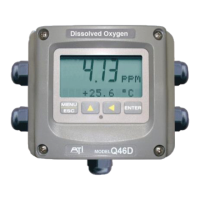53
O&M Manual
Rev-N (4/21)
Part 10 – Troubleshooting
10.1 General
The information included in this section is intended to be used in an attempt to
quickly resolve an operational problem with the system. During any
troubleshooting process, it will save the most time if the operator can first
determine if the problem is related to the analyzer, sensor, or some external
source. Therefore, this section is organized from the approach of excluding any
likely external sources, isolating the analyzer, and finally isolating the sensor. If
these procedures still do not resolve the operational problems, any results the
operator may have noted here will be very helpful when discussing the problem
with the factory technical support group.
10.2 External Sources of Problems
To begin this process, review the connections of the system to all external
connections.
1. Verify the analyzer is earth grounded. For all configurations of the analyzer,
an earth ground connection MUST be present for the shielding systems in
the electronics to be active. Grounded conduit provides no earth connection
to the plastic enclosure, so an earth ground wiring connection must be made
at the power input terminal strip. Use the special “shield terminal” stub on
the power supply board for optimum sensor cable shield grounding.
2. Verify the proper power input is present (115/230 VAC.)
3. Verify the loads on any 4-20 mA outputs do not exceed the limits in the
Instrument Specifications (500 Ohms each for analyzer.) During
troubleshooting, it is many times helpful to disconnect all these outputs and
place wire-shorts across the terminals in the instrument to isolate the system
and evaluate any problems which may be coming down the analog output
connections.
4. Do not run sensor cables or analog output wiring in the same conduits as
power wiring. If low voltage signal cables must come near power wiring,
cross them at 90° to minimize coupling.
5. If rigid conduit has been run directly to the Q46 enclosure, check for signs
that moisture has followed conduit into the enclosure.
6. Check for ground loops. Although the membrane sensor is electrically
isolated from the process water, high frequency sources of electrical noise
may still cause erratic behavior in extreme conditions. If readings are very
erratic after wiring has been checked, check for a possible AC ground loop
by temporarily placing the sensor into a bucket of water. The reading should
be initially stable and then fall very slowly in a smooth fashion as the
powered sensor depletes oxygen in the static sample directly at the sensor
face.

